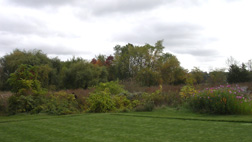A Purple Loosestrife Biocontrol Project at Fresh Pond Reservation
|
In the summer of 2006, Friends of Fresh Pond Reservation (FFPR) made an offer to the Cambridge Water Department (CWD) to help set up a project for the biocontrol of purple loosestrife at Fresh Pond Reservation. They asked that the CWD purchase the beetles with the understanding that the Friends would provide volunteers to monitor beetle proliferation and damage to purple loosestrife plants. A meeting was arranged with Beth Suedmeyer, coordinator of the Massachusetts Office of Coastal Zone Management's Purple Loosestrife Biocontrol Project. After a tour of the Reservation, she agreed that it is an appropriate site for the use of Galerucella beetles. |
| She also concurred that a wetland on the golf course just to the north of Little Fresh Pond would be a good place to begin releasing beetles in the spring of 2007. The wetland harbors a dense stand of purple loosestrife that has crowded out a variety of native species such as cattails, asters, vervains, and goldenrods. |
 |
 |
Beth provided
us with a CZM guidance document The Wetlands Restoration
Program requests that field |
| Monitoring
quadrat with PVC frame and metal pipe anchors © 2006 E. Wylde |
The protocol recommends that release sites be monitored each spring and fall for up to 5 years, until the beetles become well established. It proposes that the monitoring be done in a number of 1-meter survey quadrats. We decided on five for an area the size of the Little Fresh Pond wetland.
Using descriptions in the document, the CWD made five 1-meter frames from PVC pipe. The frames were distributed in the wetland, and metal pipes were pounded into the ground on diagonal corners to act as permanent markers, as shown in the photo, left. A GPS reading was made at each quadrat to determine the exact location.
 |
The CWD and FFPR offered an introductory program for the public on November 4, 2006. After the talk, participants who wished to volunteer for the Project were invited to join program leaders at the Little Fresh Pond wetland. Teams of two or three people counted stems, flower stalks, and density of flowers; and measured heights of plants. The data they collected will be used as a baseline against which to compare purple loosestrife growth next fall after the beetles have spent the summer feeding on the plants. | |
| Volunteers
prepare to conduct surveys in the wetland © 2006 David R Levitt |
After the survey
the PVC frames were removed for the winter. In June of 2007 they will
be replaced in the same locations using the permanent metal pipes as
guides.